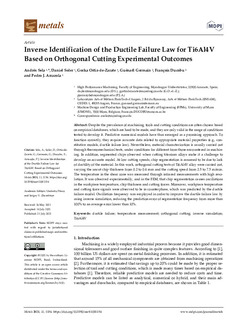Izenburua
Inverse Identification of the Ductile Failure Law for Ti6Al4V Based on Orthogonal Cutting Experimental OutcomesBeste instituzio
Université de Mons (Bélgica)Arts et Metiers Institute of Technology
Bertsioa
Bertsio argitaratua
Eskubideak
© 2021 by the authors. Licensee MDPISarbidea
Sarbide irekiaArgitaratzailearen bertsioa
https://doi.org/10.3390/met11081154Non argitaratua
Metals Vol. 11. N. 8. N. artículo 1154,Argitaratzailea
MDPIGako-hitzak
ductile failuretemperature measurement
Orthogonal cutting
inverse simulation
Laburpena
Despite the prevalence of machining, tools and cutting conditions are often chosen based on empirical databases, which are hard to be made, and they are only valid in the range of conditions tested to ... [+]
Despite the prevalence of machining, tools and cutting conditions are often chosen based on empirical databases, which are hard to be made, and they are only valid in the range of conditions tested to develop it. Predictive numerical models have thus emerged as a promising approach. To function correctly, they require accurate data related to appropriate material properties (e.g., constitutive models, ductile failure law). Nevertheless, material characterization is usually carried out through thermomechanical tests, under conditions far different from those encountered in machining. In addition, segmented chips observed when cutting titanium alloys make it a challenge to develop an accurate model. At low cutting speeds, chip segmentation is assumed to be due to lack of ductility of the material. In this work, orthogonal cutting tests of Ti6Al4V alloy were carried out, varying the uncut chip thickness from 0.2 to 0.4 mm and the cutting speed from 2.5 to 7.5 m/min. The temperature in the shear zone was measured through infrared measurements with high resolution. It was observed experimentally, and in the FEM, that chip segmentation causes oscillations in the workpiece temperature, chip thickness and cutting forces. Moreover, workpiece temperature and cutting force signals were observed to be in counterphase, which was predicted by the ductile failure model. Oscillation frequency was employed in order to improve the ductile failure law by using inverse simulation, reducing the prediction error of segmentation frequency from more than 100% to an average error lower than 10%. [-]
Sponsorship
Gobierno de EspañaProjectu ID
GE/Convocatoria 2018 de proyectos de I+D+i «Retos Investigación», del Programa Estatal de I+D+i Orientada a los Retos de la Sociedad, en el marco del Plan Estatal de Investigación Científica y Técnica y de Innovación 2017-2020/RTI2018-094435-B-C31/ES/Fabricación aditiva de compuestos termoplásticos reforzados con fibra para transporte, salud y deporte/Bildumak
Item honek honako baimen-fitxategi hauek dauzka asoziatuta:























